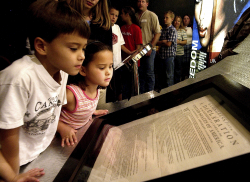After 40 years of service, the AV-8B Harrier II is being retired, with some aircraft heading to museums as the Marine Corps transitions to the F-35B.
In late May, Marine Attack Squadron 231 (VMA-231), the “Ace of Spades,” carried out the final flight of its AV-8B Harrier II after 40 years of service. The famed unit, the oldest United States Marine Corps flying squadron, can trace its origins back to 1919, and for nearly half of its existence, it flew the Harrier II.
The aircraft saw service with VMA-231 in various combat operations, including Desert Storm, Allied Force, Odyssey Dawn, Inherent Resolve, and, most recently, Prosperity Guardian, against the Iranian-backed Houthi militants in December 2023.
Marine Attack Squadron 223 (VMA-223) now remains the final squadron to operate the Harrier II, with plans to deactivate by September 2026. That will mark the end of the line for the famed (and at times controversial) aircraft.
The USMC continues to transition to the fifth-generation Lockheed Martin F-35B Lightning II, which offers similar short takeoff and vertical landing (STOVL) capabilities, along with stealth, superior range and speed, and more advanced sensor fusion.
Where Will the Harrier II Jets Be Sent?
It will become increasingly rare to see the Harrier II in the skies, but it was recently announced that at least two retired AV-8B Harrier II fighters are now heading to museums. Oregon’s Tillamook Air Museum is set to receive an AV-8B flown from Naval Air Weapons Station China Lake, California, in early August.
According to Vintage Aviation News, the retired USMC combat aircraft had 5,518 flight hours and saw “service in Iraq, Syria, and the Arabian Gulf.” It was delivered to the USMC on March 30, 1995, and flew combat missions from the US Navy amphibious assault ships USS Nassau (LHD-4), USS Peleliu (LHD-5), and USS America (LHD-6). It concluded its military service with the US Navy Air Test and Evaluation Squadron 31 (VX-31), the “Dust Devils.”
The aircraft will be on “permanent” loan (meaning the USMC still owns it) from the National Naval Aviation Museum, Florida. That latter museum doesn’t have a Harrier II in its current collection, but does have a Hawker Siddeley Harrier.
The AV-8B will fly directly from the US Navy’s research and test facility in the Mojave Desert to Oregon under its own power. In contrast, a Marine Corps “demilitarization crew” will fly with it in a US Air Force C-17 Globemaster III to prepare the aircraft for static public display.
“This aircraft represents an extraordinary chapter in modern military aviation,” said Christian Gurling, Curator of the Tillamook Air Museum. “We are proud to accept this historic piece of Marine Corps history.”
Another AV-8B+ Harrier II has also been loaned to the Wings Over the Rockies Air & Space Museum. It will make its official debut on Friday, August 1, with plans for a cockpit tour on August 9 during the museum’s regular Cockpit Demo Day.
“We’re incredibly honored to preserve the Harrier’s story and share its legacy with future generations,” Marcus A. Harshaw Jr., Wings Over the Rockies Air & Space Museum CEO and president, told 9News.com. “This aircraft isn’t just another jet, it’s a game-changer that redefined how air support could be delivered.”
The United States Marine Corps operated a total of 215 AV-8B Harrier IIs, including the TAV-8B two-seat trainers. With the VMA-223 now scheduled to deactivate the final Harrier IIs next year, more of these iconic fighters could soon be landing at other museums around the country, preserving their legacy.
About the Author: Peter Suciu
Peter Suciu has contributed over 3,200 published pieces to more than four dozen magazines and websites over a thirty-year career in journalism. He regularly writes about military hardware, firearms history, cybersecurity, politics, and international affairs. Peter is also a Contributing Writer for Forbes and Clearance Jobs. He is based in Michigan. You can follow him on Twitter: @PeterSuciu. You can email the author: [email protected].
Image Credit: Shutterstock/BlueBarronPhoto.


















